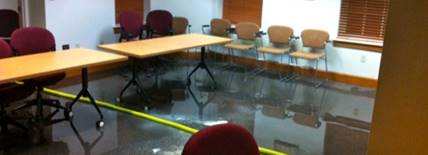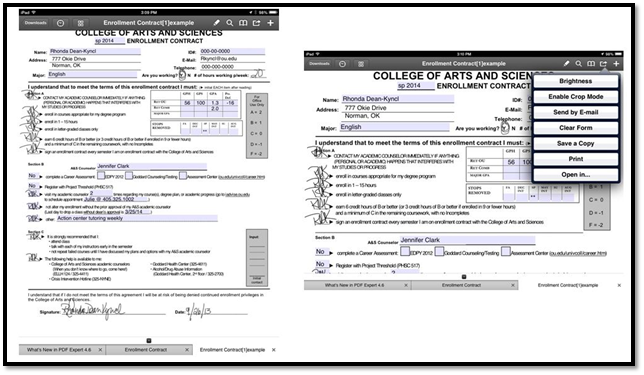Key Takeaways
- This case study provides an example of how digital records and mobile technology improve communication between students, departments, and offices while reducing administrative tasks and costs.
- With mobile technology, students and advisors can meet anywhere on campus and access electronic documents, increasing student awareness of their academic standing and contractual stipulations.
- Addressing the needs of today's tech-centric students can be done in tandem with the fulfillment of business and administrative goals to achieve core university missions.
Rhonda Dean-Kyncl is assistant dean in the College of Arts and Sciences, University of Oklahoma Central Office.
One of the ways universities can improve educational quality is by more actively engaging with students as they progress through their degree programs. Using technology to engage with students and provide better student service has become crucial for universities aiming to prove their value while achieving cost-efficiency goals and meeting the high expectations of learners and regulators.
This case study explores how the University of Oklahoma College of Arts and Sciences — the largest college on campus with approximately 7,000 students, 50 majors, and 28 departments — found an opportunity to improve student-advisor communication, cut administrative costs, and demonstrate value through a mobile digital records system.
The Urgency of Going Mobile
In 2009 a flood caused a water pipe to burst in the Academic Services Office, putting the contents of the building — particularly student records — at serious risk. (Figure 1 shows a flooded classroom.) The paper records were spared, fortunately, but we realized we could not continue storing essential documents on such a vulnerable format. As the largest college on campus, we had the most to lose if these records were damaged or lost.

Figure 1. A flooded room in the south end of the Academic Services Office
The flood forced us to create a disaster recovery strategy, and we began gathering requirements for a digitized records system. However, we soon recognized that a complete overhaul of our advising methodology would have a wider impact across the college than simply archiving our files in a digital format. Rather than limit our attention to records archiving, we considered the entire lifecycle of our records — how records entered our office, the processes we relied on to manage them, and how we could change those processes to benefit, not burden, our staff and students.
As we expanded our requirements to include document and business process management, we realized the transitional period between the junior and senior years was often the most critical — and most difficult — time to maintain consistent documentation. The Academic Services Office guides seniors toward graduation, but making sure all the requirements have been met cannot be done without complete and accurate information. Often, seniors had to gather the necessary documents from multiple teachers and departments, creating bottlenecks, confusion, and opportunities for error. Advisors also had to gather documentation, which could be located in storage, on desks, or, worst of all, in the wrong folder. Finally, all this information requires stringent privacy requirements in any system used to manage it.
Once we added proprietary workflow to our selection criteria for a software solution, the vendor pool narrowed quickly. Most companies simply did not offer a reasonably priced workflow component. After we spoke with the university's director of admissions, whose department already used digitized records software compatible with the main campus's Banner student information system (SIS), one company jumped to the top of the list because it offered customizable workflows, local technical support, and reasonable pricing in comparison to competitors. (For example, the cost was 60 percent less annually than another company that didn't offer workflow functionality.) In 2011, the Academic Services Office selected Laserfiche as its enterprise content management (ECM) vendor.
Top Five Selection Criteria for an ECM
- Ability to integrate with our SIS
- Ability to automate processes (vs. simply storing digital files)
- Presence of a local support team
- Ability to provide secure mobile access to document repository
- Compatible with programs used by other offices on campus
We collaborated with our reseller to map out and reengineer our paper-based advising system; within a few weeks, our reseller demonstrated an advising workflow. After revisions and approval, the reseller came to our offices to load the software onto our main server, conduct training sessions, and facilitate the implementation. Though the reseller intended to stay on campus for a full week, it took staff in the Academic Services Office only one day to adjust to the new system because of the intuitive interface.
The vendor and our reseller continue to provide technical support, software upgrades, and training on system updates and new products. A few times a year, our reseller will help us integrate new applications with our ECM system, offer free online training courses, and even visit our campus to set up new hardware when needed. We can make adjustments to our workflows in-house, as well.
Applications
The implementation stage revealed how many documents, business processes, and student-advisor relationships could potentially be managed through the new software and its mobile app. The ability to remotely access student records led to the following possibilities:
- Throughout the school year, students can conveniently access academic documents and forms from their own devices, which helps them stay on track with university requirements.
- Staff members can work from home during school breaks, keeping productivity and responsiveness consistent through the holidays.
- Students and counselors can meet in locations other than the Academic Services Office and review electronic documents from an iPad. For time-strapped students and advisors, this flexibility makes meetings both more convenient and more likely to occur.
Academic Contracts
In particular, we found exciting potential in the academic contract process. When students at the college fail to meet minimum GPA requirements, they are placed on academic contract. These students must meet with an academic counselor once a semester, follow strict contract stipulations, and work to regain acceptable academic standing. Today, this process is automated through mobile ECM. After a student receives an e-mail notifying him of his academic contract status, a copy of this e-mail is automatically stored in the student's folder within a digital repository. When the counselor and student meet to review the contract form (figure 2), it can be completed and signed on an iPad using a finger or a stylus. The official academic contract is also e-mailed to the student and stored in a digital repository, where the counselor can access it at any time.

Figure 2. Sample academic contract
Automatic e-mails, document routing, and digital signatures enable counselors to spend more time advising students and less time handling administrative tasks. Having student records that are not only well organized but accessible from a mobile device helps our counselors provide better service to students.
This process also improves students' awareness of contract stipulations and ensures that they have access to those stipulations throughout the semester. By making it easier for students to keep track of their contracts, we are stretching the capabilities of mobile ECM to not only eliminate paper documents but also positively affect the student experience.
Remote accessibility to student records has also improved group advising sessions. During these sessions, often conducted on the basis of a shared major, faculty mentors and advisors meet with students to discuss academic goals. Before we adopted mobile ECM, the Academic Services advisor was limited by what she could carry, and if an unexpected student showed up she had no way of retrieving the necessary files. Now, she has secure, role-based access to a digital repository of student records on an iPad. This enables her to produce information on the fly, as well as share files with colleagues and students on a convenient mobile device.
For the Academic Services Office, mobile ECM has evolved into a multidimensional solution. We are:
- containing operational costs by reducing paper waste,
- gaining a competitive advantage by integrating mobile technology into our processes, and
- enabling student success.
Outcomes and Benefits
The Academic Services Office has seen the most immediate improvement from implementing a digital ECM system in information access. Documents are no longer held hostage in storage rooms or piles of paper on desks, and turnaround time for records requests has fallen dramatically. At the same time, privacy and user-access settings in the system have improved information security.
In terms of hard savings, we've reduced yearly spending on salaries, supplies, and mail by $20,000. The ROI breaks down into the following savings:
- $15,000/year for two student file clerks
- $8,000/year on staff costs associated with processing graduation cards
- $1,000/year on a manual file management system
- $1,300/year on file and office supplies
- $1,080/year on postal services
- One copy machine lease
- Reclaimed office space
The Academic Services Office realizes the advantage of mobile ECM most poignantly during winter break. This three-to-four-week recess has always been a stress point for our staff, as students must be processed for changes of major, changes of academic standing, and course additions and withdrawals. Working under a manual system, the office struggled with timeliness and efficiency, but since implementing a mobile ECM system, staff can work seamlessly between locations and devices. During the most recent winter break, two staff on leave were able to manage tasks from home. This mobile capability is also critical for students, as they can submit forms online and receive automatic status updates via e-mail, saving them time and effort.
In an office of only 17 employees, the ability to keep communication and information flowing is essential. According to Academic Counselor LaRee Saunders,
"The ease of retrieving student records within an instant has made our daily tasks much more efficient. Rather than having to physically search among thousands of student files, I can simply type in a student identification number and within seconds every document I might need is before my eyes; no more time wasted searching, refilling, or trying to find misplaced hard files. This improvement in efficiency has greatly benefited my students as I have been able to reduce the turnaround time for e-mail correspondence, forms, phone calls, and voicemails. By doing so, I better serve my students with each interaction."
Expansion Campus-Wide
Several business units and colleges across the University of Oklahoma have independently adopted the same ECM system. Even before the 2009 flood, the Admissions Office had implemented its own ECM system, and the Honors College, the College of Education, units within the athletic department, and legal counsel followed suit. In the summer of 2014 the University of Oklahoma will move to a shared-service model to minimize support and maintenance costs, with the central IT department supporting the campus-wide ECM system. This shared-service model will allow the university to leverage economies of scale, share skill sets between units, and piggyback off the efforts of colleagues.
© 2014 Rhonda Dean-Kyncl. The text of this EDUCAUSE Review online article is licensed under the Creative Commons Attribution-NonCommercial-NoDerivs 4.0 license.
